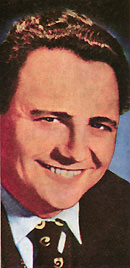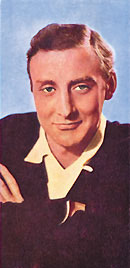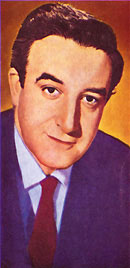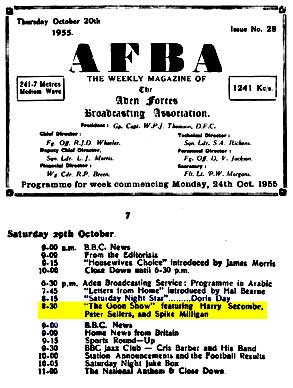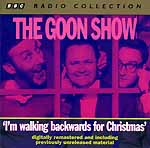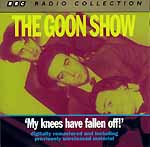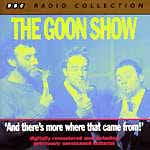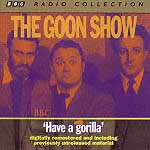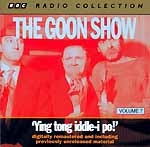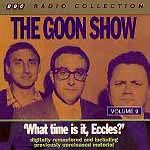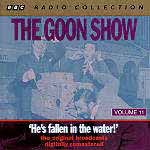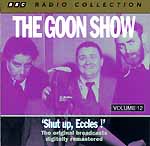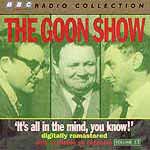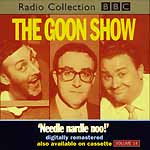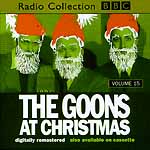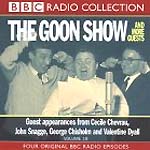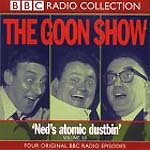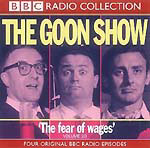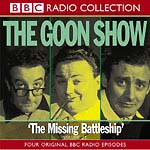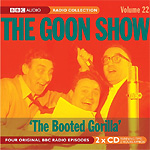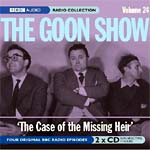|
||||||||||||||||||||||||||
| Contents of this Chapter: | ||||||||||||||||||||||||||
| Introduction... Goon Shows Preserved While You Wait... The Wonder of Ultra-Kendall-Vision... Running Jumping & Standing Still... Let's See Them Do That On Television! Telegoon Toon Time... Voice Actors, Puppeteers & Producers Go Ask Eccles & Bluebottle The Persistence of Goon Memory... Neddie Seagoon Puppet Restoration Fund... |
||||||||||||||||||||||||||
|
|
||||||||||||||||||||||||||
Radio's Crazy Gang--"The Goons"... |
||||||||||||||||||||||||||
Initially billed (against the Goons� wishes) as CRAZY PEOPLE, featuring Radio�s Crazy Gang--�The Goons�, The Goon Show first aired 28th May, 1951, and revolved around the voice talents of Peter Sellers, Harry Secombe, Spike Milligan, and (briefly) Michael Bentine. Musical breaks were provided by The Ray Ellington Quartet, The Stargazers (who left after the first six shows), and Max Geldray. The Wally Stott Orchestra performed the signature tune, and did the various musical link passages, assisted by the Ray Ellington Quartet in the rhythm section. Grams and Spot sound effects were provided by various people, including John P. Hamilton who has shared his experiences extensively with the GSPS (See newsletters: #81, #82, #83, #84, #85, #86, #92, #94, and the following GSPS video recordings: An evening with John P. Hamilton, 1995; A weekend called Fred, 1995; An Evening with Fred, 1996; Son of a weekend called Fred, 1997). In the wake of the post-war euphoria that swept Britain in the late 1940s, the �50s provided a fertile ground for new ideas, including new ideas for comedy. Besides, the BBC had been losing some of its top comedians to the private sector and needed to bolster up its offerings. Emerging from this environment, The Goon Show struck a deep chord, particularly in the younger segment of the radio audience, and quickly developed a large following that today, 50 years later, is still extremely loyal. A large part of the show�s continued success resides in its ability to take the listener out of this world, stretching the imagination way beyond the normal limits of common sense and logic. As Peter Sellers recalled (TIME, March 3, 1980), �Our premise was taking serious ideas--or any idea at all--to their illogical conclusion.� In discussing the origins of The Goon Show, Spike Milligan (Australian PIX, June 6, 1964) said that the show was conceived �as a means of lampooning everything ridiculous about modern living.� In his introduction to The Book of The Goons (Elizabeth Rose, ed.), long-time producer of the shows, Peter Eton, put it this way: �Unlike any other radio programme of its time, The Goon Show was less a criticism of any social system than a bold and melodramatic rearrangement of all of life.� Nowhere is this more apparent than in the diverse personalities of the eccentric but likeable characters that populate the Goon world. It is these same larger-than-life characters and their human foibles that give the show much of its enduring appeal. No other radio comedy show has had the lasting impact of The Goon Show, an impact that continues to be felt, even by television. Just as The Goon Show turned British radio comedy on its ear, another comedy show, Monty Python�s Flying Circus, in turn, revolutionized British TV comedy. The Pythons have, however, given much of the credit to Spike Milligan, and on many occasions have said that without The Goon Show, and Spike's Q television series, there would be no Monty Python show. As Python co-founder Terry Jones recalled in a recent radio interview, �I thought...what can we do to Python to make it different...hoping to make it ground breaking the way that the Goons...was ground breaking on radio...then seeing Q5, and suddenly thinking, Uh Oh! Milligan�s done it already.� As put by David Morgan, author of Monty Python Speaks (see Bibliography section), �If there is a progenitor to credit (or blame!) for Monty Python, the innovative and surreal comedy group that turned the BBC and cinema screens on their ends, one need look no further than a tall, undisciplined, manic-depressive Irishman...� Spike�s comedic genius was further acclaimed by the readers of BBC News Online, who voted him the funniest person of the millennium, ahead of Monty Python�s John Cleese, and such luminaries as Charlie Chaplin, Stan Laurel and Oliver Hardy (September 1999). The audience size for the original Goon Show broadcasts in the UK grew rapidly, and by the 6th series (September 1955 through March 1956) had reached 7,000,000 for some shows (see table). The figures after this declined somewhat, due to the increasing impact of television. Considering that in March 1955 there were 9,414,224 radio licenses and 4,503,766 combined radio and television licenses, the 5th series Goon Show audience was a significant proportion of the radio audience. By the middle of the 6th series (end of November, 1955), radio licenses had decreased by 458,600, and combined radio and television licenses had increased by 757,933. Obviously a lot of the UK radio audience were starting to spend time in front of the television set, rather than listen to the radio! Although Goon Show repeats have been somewhat thin on the ground in the UK since the series ended in 1960 (despite Milligan�s efforts with the BBC), outside the UK the situation has been quite different. By 1967, the list of countries still enjoying regular radio broadcasts of the Goon Show included New Zealand, Australia, Canada, USA (Public Broadcasting Service), Bermuda, Hong Kong (to the British Forces community), and Aden (ditto). Thirty five years later the list is a lot shorter, and apart from Australia, which seems to be a special case (see below), regular radio broadcasts seem to be a thing of the past. One good, but erratic, source of information is the Internet newsgroup alt.fan.goons, which has carried occasional reports of broadcasts in New Zealand, Canada, and the USA. During all of the 1960s, 70s, and most of the 80s, New Zealand�s National Radio programme (stations 1YA, 2YA, 3YA, and 4YA) repeated the shows every Sunday at 9:00 p.m. More recently, starting May 1999, Radio New Zealand broadcast, at 3:30 p.m. on Saturday afternoons, a series of six of the finest Goon Shows. The aim was not to satisfy any pent-up thirst for more shows. Instead it was to find out �what the 1999 audience makes of Bluebottle� (NZ Listener, May 1st, 1999). I have yet to find out what was the outcome of this research. The country that ranks as number one in Goon Show popularity outside the UK is not the land of the kiwi, but instead the land of the kangaroo...where the Goons became one of the most revered national institutions, and also where (is there a connection here?) many of the Milligans made their home. As of mid 2000, The Goon Show is still repeated twice-weekly by the Australian Broadcasting Commission (ABC). Interestingly, although transcription discs were available much earlier, ABC Radio did not actually start broadcasting The Goon Show until 1956 (6th Series). A total of more than 240 Goon Show scripts were written, mainly by Spike Milligan, but more often than not assisted by professional script-writer Larry Stephens. Significant script contributions were also made by Jimmy Grafton, Eric Sykes, Maurice Wiltshire (more about him later), and John Antrobus. In the first three series, it was Jimmy Grafton�s editorial hand that helped moderate Spike�s extreme flights of imagination, making the shows more comprehensible to the average listener. The shows were rehearsed on Sunday afternoons, and then were recorded in front of a live studio audience the same evening. The venue was the BBC�s London studios. The show�s main characters were provided by the voices of Spike Milligan (Eccles the original Goon, Miss Minnie Bannister, Moriarty), Sir Harry Secombe (Neddie Seagoon, in various guises as Inspector~, Chief Commissioner~, Dr~, Lieutenant~, Hairy Seagoon, Ned of Wales, Gas Meter Inspector Ned Seagoon, etc., etc.), and Peter Sellers (Bluebottle, Mr. Henry Crun, Major Dennis Bloodnok, Grytpype-Thynne). �The Goon Show was a phenomenon whose overall influence was greater than the sum of its individual programs. And its legacy has spread to generations who never heard the original broadcasts,� said the great English humourist Frank Muir (1920-1998), as presenter of the BBC radio documentary A Sound of Goons. �Even to those who�ve never heard the repeats. There are schoolchildren now who imitate their parents� imitations of Bluebottle, who say �He's fallen in the water�, who tell each other to �Shut up, Eccles!�, who call each other �dirty rotten swine�, �silly twisted boy�, or even just �Jim�. They may not be aware of their debt, but they owe it all to The Goon Show--a highly combustible mixture of volatile elements which managed--that difficult task--to make people laugh.� |
|
|||||||||||||||||||||||||
| |
||||||||||||||||||||||||||
Next section in this chapter: Goon Shows Preserved While You Wait... |
||||||||||||||||||||||||||
